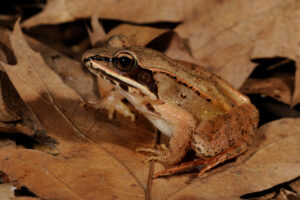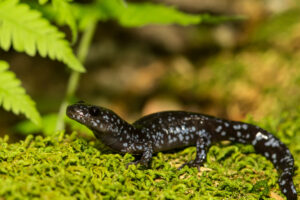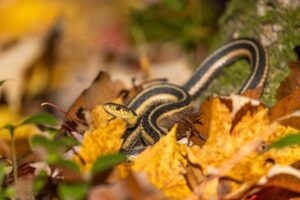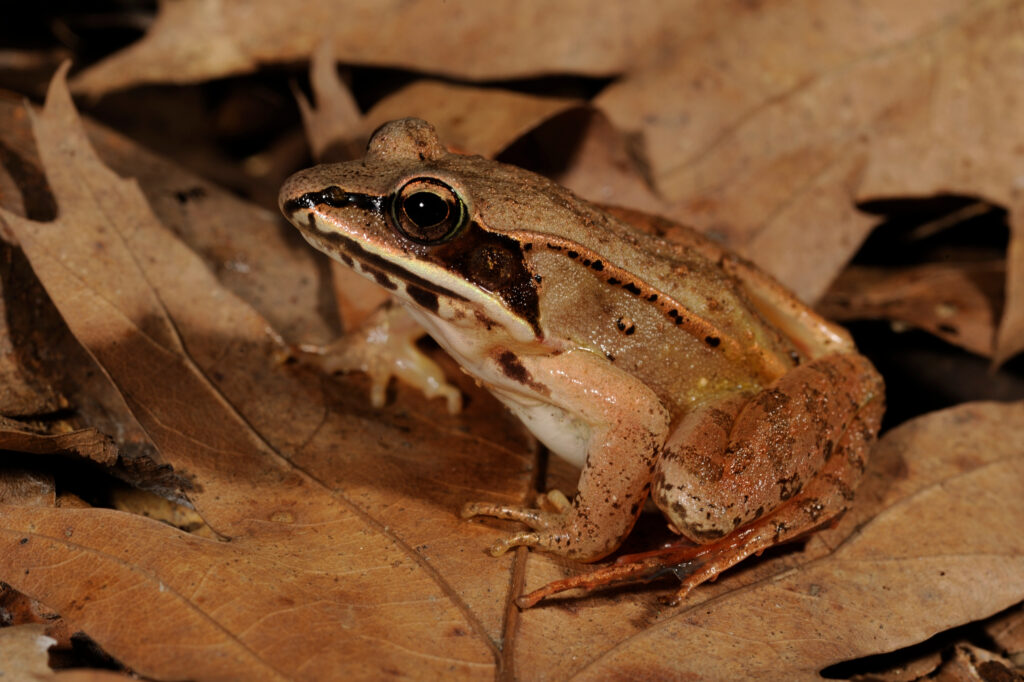Last week, we discussed the first signs of spring in the bird world and which birds are the early bird migrators of Wisconsin. This week, we would like to discuss some of our cold-blooded friends, amphibians and reptiles, that begin to awaken as the warmer temperatures of spring arrive. Since amphibians and reptiles are ectothermic, relying on their environment to regulate their heat (such as sunlight and heated rocks), the warmer temperatures of spring are vital for them after the frigid months of winter. In some cases, such as frogs, their bodies go through a process during the winter months in which they create their own “antifreeze” to protect themselves from the colder temperatures. Some species of frogs, such as the wood frog, become frozen frog popsicles, requiring them to thaw out during the spring. In other cases, such as with the blue-spotted salamander and the common garter snake, they go into a state of brumation, a sluggish, inactive state, where they may sleep here and there but not as intense as hibernation. Although they are still somewhat active during brumation, these critters rely heavily on the warmer spring days to get their bodies moving again. Now that we have an overview, let’s discuss why these three species are considered first signs of spring in the amphibian and reptile world.
Wood frogs are tiny frogs, roughly two to three inches in length. They can be shades of brown, red, green, or grey, with a yellowish or greenish-white underbelly and a white stripe on their upper lip. One of the easiest ways to identify wood frogs is by the dark “mask” around the frog’s eyes. They are found in the Northeastern part of the United States, parts of the Midwest, and almost all of Canada and Alaska. They can be found in deciduous, coniferous, and mixed forests near marshes, meadows and swamps. Out of all the amphibians and reptiles of North America, wood frogs are the only species found as far North as the Arctic Circle!

During the winter, the wood frog’s body produces an “antifreeze” that prevents the wood frog’s cells from freezing while the space around them freezes. During this frozen state, the wood frog’s breathing and heartbeat stop! If you ever find one in this state, it appears to be dead and frozen solid. Once things warm up in the spring, the wood frog begins to thaw from the inside out, jump-starting it’s lungs, heart, and brain. Once completely unthawed, the mating season has begun, typically from March through May.
Although a diurnal species, in which they are active in the day, during the breeding seasons, males make a quacking or chuckling call throughout the day and night. Unlike other frogs, such as the spring peeper, which lay their eggs in the stagnant waters of swamps, bogs, and marshes, wood frogs use vernal pools to lay their eggs. Vernal pools are small ponds created by snow melt or groundwater that eventually dry up in the summer. The males will hang out near these pools until the females arrive. Due to their inability to recognize each other by sex, the males will come up behind another frog and give them a “hug.” By hugging the other frog, the male can determine whether or not his hug partner is a male or a female based on the size of the other frog. If the frog receiving the hug feels larger than the male giving the hug, then he knows it is a female full of eggs. Not only do male wood frogs sometimes hug the wrong sex, but their excitement can lead them to hug a different species altogether! Male wood frogs have been known to accidentally hug other species of frogs, toads, and even salamanders! Lucky for them, it’s just a free hug, and they can carry on with their day.
Click below to hear the “quacking” of wood frogs from a clip on our podcast “WildPhiles” where wildlife rehabilitator Sheridan Perry goes into some fascinating details about amphibians.
Once the male has found the right mate, he squeezes her until she deposits her eggs. As the eggs leave her body, he fertilizes them. Each female can lay anywhere between one thousand and three thousand eggs! Females will lay their eggs alongside other female’s eggs, creating a giant mass of eggs on the water’s surface. Laying their eggs close to each other gives them the appearance of a floating mass of pond muck, making them look unappetizing to predators. Since their breeding season is from March to May, eggs laid in colder waters can take up to a month to hatch, while eggs laid in warmer waters can take up to two weeks. Ironically, when the wood frog tadpoles hatch, they can recognize siblings, often congregating with each other rather than with the other tadpoles. Although not completely understood, this recognition disappears as they develop into frogs, and love hugs become the only way for them to distinguish between males and females.
The blue-spotted salamander is a type of mole salamander mainly found near and around the Great Lakes. Although commonly found around the Great Lakes, they can also be found in the Northeastern United States, Quebec, and parts of Ontario, Canada. Their habitat consists of deciduous hardwood forests and swampy woodlands. Their skin is bluish-black, with bluish-white spots on their sides, limbs, and tails. They are typically three to five inches long, with long toes, a slender body, and a tail almost half the size of their body length.

Blue-spotted salamanders bury themselves deep into the ground past the frost line during winter. As spring comes along, snow is rapidly melting from warmer temperatures and rain, and blue-spotted salamanders make their way to the earth’s surface. Once out of their burrows, they head towards vernal pools and begin their courtship in the water. Not only is their migration towards these vernal pools a first sign of spring, but it is also one of the only times of the year that you can easily find a blue-spotted salamander. Once they reach these vernal pools, both males and females make their way into the water. The male nuzzles and nudges at the female with his snout, then makes his way on top of her, rubbing his chin on her head and snout. The pair will stay in this position for several hours, occasionally rising to the surface. Eventually, the male lets go of the female and lays a sperm sac in front of her, known as a spermatophore. The female will then take in the spermatophore with her cloaca, the rear opening of all amphibians, reptiles, and birds, where reproduction and waste removal occur. She then lays small clutches of eggs on the rocks and plants within the vernal pool. In total, she will lay roughly five hundred eggs, with each clutch containing up to twenty-five eggs. It takes about one month for the eggs to hatch. Once they hatch, the young stay in the vernal pools for another seventy to one hundred days as they develop. In recent years, due to climate change, this period of development has become somewhat of a game of Russian roulette, in which vernal pools are drying up sooner than usual, resulting in the death of some of the young before they can leave the vernal pools.
The common garter snake is the most prevalent snake across the United States. These snakes are typically four feet long, and their colors vary from black, brown, green, or olive. They have three light stripes running down their body, with one stripe running down the center and the other two running alongside the central stripe. Sometimes, these stripes have dark spots, giving them more of a checkerboard pattern. Common garter snakes can be found in woodlands, meadows, and along the edges of waterways, preferring moist, grassy environments. They are diurnal snakes that are often seen basking on trails or rocks on cool spring days to warm themselves up.

During winter, common garter snakes brumate in natural cavities such as other critters’ abandoned dens, under rock piles, or in stumps. They often brumate in large groups to keep each other warm. As temperatures rise in the spring, male common garter snakes will come out of their dens first, with only one thing on their minds: breeding. Even after months of little to no food, the male’s mind is set. As the females start to leave the den, their pheromones make the males go wild, and they quickly swarm the females. More often than not, a single female may have a dozen or more males trying to mate with her simultaneously, creating what is known as a “snake ball.”
Although males emerge from their dens before females, sometimes “lazy” males stay in the den longer than others. As these males emerge from the den, they need to catch up on the mating game, but they are also quite cold from the lack of bodies warming them up during the winter months. Due to this, these males play a trick on the other males by releasing female pheromones. Other males catch a whiff and form a ball around the colder male snake, warming him up. By taking in the heat from the males surrounding him, he does not need to use up any of his energy resources and, therefore, has more energy to breed with as many females as possible. This behavior is known as kleptothermy, which, in simple terms, means warmth-sucking behavior.
After a male and female mate, the male will find another female to mate with. In contrast, the female will go to her summer habitat and wait for the inevitable birth of her young. Female common garter snakes are ovoviviparous, meaning the eggs are incubated within the female’s lower abdomen, but instead of laying the eggs, she gives birth to live young. The females typically have a litter of ten to forty young, but they have been known to have up to eighty in a litter. Although the young may hang out near the female, she does not provide parental care for them, and they must learn the ropes of life in the wild on their own.
Stay tuned for our final episode of “First Signs of Spring,” in which we discuss the mammals that emerge from their winter slumber when the warmer temperatures of spring arrive. If you would like to learn more about amphibians and reptiles, keep a look out for our upcoming Podcasts on each of these subjects.
Thank you to the following sources for the information for this post:
Wood Frog | National Wildlife Federation (nwf.org)
Ten Facts about Wood Frogs – Nature for my Soul
Wood frog – Facts, Diet, Habitat & Pictures on Animalia.bio
Wood Frog Animal Facts | Lithobates sylvaticus – A-Z Animals (a-z-animals.com)
ADW: Ambystoma laterale: INFORMATION (animaldiversity.org)
Blue-spotted Salamander Fact Sheet
Blue-Spotted Salamander | Vermont Fish & Wildlife Department (vtfishandwildlife.com)
Blue-spotted salamander Facts for Kids (kiddle.co)
Common Garter Snake (Thamnophis sirtalis) · iNaturalist
Common Garter Snake – Wildlife in Winter
Five Wild Facts About Oh-So-Common Garter Snakes (willyswilderness.org)

